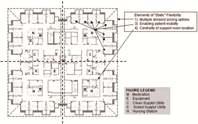Inpatient Unit Design: Defining the Design Characteristics of a Successful Adaptable Unit

In view of the massive investment being made into inpatient units, this research aimed at ascertaining: 1) what flexibility means to different stakeholders of care delivery, 2) what physical design variables stakeholders identify as dimensions of architecture that influence flexibility, and 3) what elements of the designs promote or hinder flexibility. This study makes a contribution to understanding flexibility at the inpatient unit level, from a viewpoint of adaptability to operational changes. The study used an exploratory design and collected data through semi-structured interviews of stakeholders in nursing, materials management, respiratory services, pharmacy, environmental services and dietary services from six hospitals across the United States. Content analysis of interview transcript suggests a set of seven ‘static’ attributes the presence of which, irrespective of size, shape, circulation, and other configurations, would ensure flexibility of operations in the short as well as long run: 1) multiple division/zoning options, 2) peer lines of sight, 3) patient visibility, 4) centrality of support, 5) resilience to move/ relocate/interchange units, 6) multiple administrative control and unit spread options, and 7) ease of movement between units and departments.


Add comment
Log in to post comments